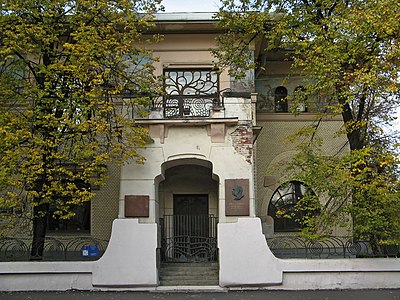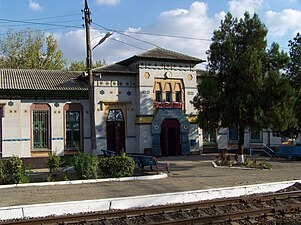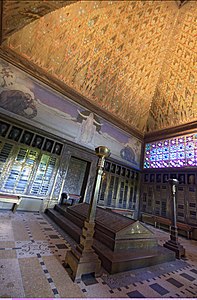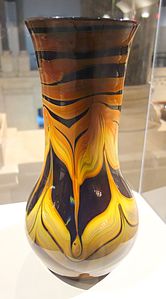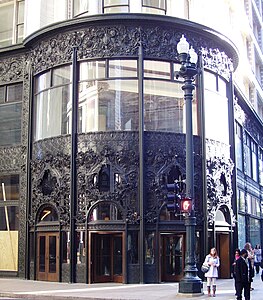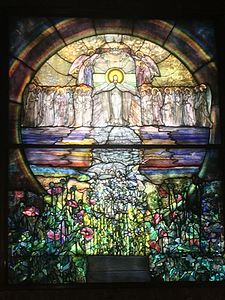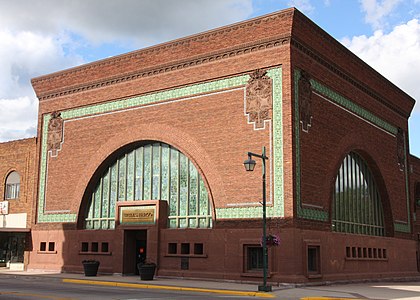Art Nouveau
Clockwise from top left: Paris Métro station Abbesses by Hector Guimard (1900); cover of Jugend magazine by Otto Eckmann (1896); wall cabinet by Louis Majorelle; interior of the Hôtel Tassel in Brussels by Victor Horta (1892–1893); lamp by Louis Comfort Tiffany (1900–1910) | |
| Years active | c. 1883–1914 |
|---|---|
| Location | Western world |
Art Nouveau (/ˌɑːr(t) nuːˈvoʊ/ AR(T) noo-VOH, French: [aʁ nuvo] ; lit. 'New Art') is an international style of art, architecture, and applied art, especially the decorative arts. It was often inspired by natural forms such as the sinuous curves of plants and flowers.[1] Other characteristics of Art Nouveau were a sense of dynamism and movement, often given by asymmetry or whiplash lines, and the use of modern materials, particularly iron, glass, ceramics and later concrete, to create unusual forms and larger open spaces.[2] It was popular between 1890 and 1910 during the Belle Époque period,[3] and was a reaction against the academicism, eclecticism and historicism of 19th century architecture and decorative art.
One major objective of Art Nouveau was to break down the traditional distinction between fine arts (especially painting and sculpture) and applied arts. It was most widely used in interior design, graphic arts, furniture, glass art, textiles, ceramics, jewellery and metal work. The style responded to leading 19th century theoreticians, such as French architect Eugène-Emmanuel Viollet-le-Duc (1814–1879) and British art critic John Ruskin (1819–1900). In Britain, it was influenced by William Morris and the Arts and Crafts movement. German architects and designers sought a spiritually uplifting Gesamtkunstwerk ('total work of art') that would unify the architecture, furnishings, and art in the interior in a common style, to uplift and inspire the residents.[2]
The first Art Nouveau houses and interior decoration appeared in Brussels in the 1890s, in the architecture and interior design of houses designed by Paul Hankar, Henry van de Velde, and especially Victor Horta, whose Hôtel Tassel was completed in 1893.[4][5][6] It moved quickly to Paris, where it was adapted by Hector Guimard, who saw Horta's work in Brussels and applied the style to the entrances of the new Paris Métro. It reached its peak at the 1900 Paris International Exposition, which introduced the Art Nouveau work of artists such as Louis Tiffany. It appeared in graphic arts in the posters of Alphonse Mucha, and the glassware of René Lalique and Émile Gallé.
From Britain, Belgium and France, Art Nouveau spread to the rest of Europe, taking on different names and characteristics in each country (see Naming section below). It often appeared not only in capitals, but also in rapidly growing cities that wanted to establish artistic identities (Turin and Palermo in Italy; Glasgow in Scotland; Munich and Darmstadt in Germany; Barcelona in Catalonia, Spain), as well as in centres of independence movements (Helsinki in Finland, then part of the Russian Empire).
By 1914, with the beginning of the First World War, Art Nouveau was largely exhausted. In the 1920s, it was replaced as the dominant architectural and decorative art style by Art Deco and then Modernism.[7] The Art Nouveau style began to receive more positive attention from critics in the late 1960s, with a major exhibition of the work of Hector Guimard at the Museum of Modern Art in 1970.[8]
Naming
[edit]The term Art Nouveau was first used in the 1880s in the Belgian journal L'Art Moderne to describe the work of Les Vingt, twenty painters and sculptors seeking reform through art. The name was popularized by the Maison de l'Art Nouveau ('House of the New Art'), an art gallery opened in Paris in 1895 by the Franco-German art dealer Siegfried Bing. In Britain, the French term Art Nouveau was commonly used, while in France, it was often called by the term Style moderne (akin to the British term Modern Style), or Style 1900.[9] In France, it was also sometimes called Style Jules Verne (after the novelist Jules Verne), Style Métro (after Hector Guimard's iron and glass subway entrances), Art Belle Époque, or Art fin de siècle.[10]
Art Nouveau is known by different names in different languages: Jugendstil in German, Stile Liberty in Italian, Modernisme in Catalan, and also known as the Modern Style in English. The style is often related to, but not always identical with, styles that emerged in many countries in Europe and elsewhere at about the same time. Their local names were often used in their respective countries to describe the whole movement.
- In Austria and the neighbouring countries then part of the Austro-Hungarian Empire, it was called Wiener Jugendstil ('Viennese youth style'), or Secessionsstil ('Secession style'), after the artists of the Vienna Secession (Hungarian: szecesszió, Czech: secese, Slovak: secesia, Polish: secesja).
- In Belgium, it was sometimes termed Style coup de fouet ('Whiplash style'), Paling Stijl ('Eel Style'), or Style nouille ('Noodle style') by its detractors.[10]
- In Britain, besides Art Nouveau, it was known as the Modern Style, or, because of the works of the Glasgow School, as the Glasgow style.
- In Denmark, it is known as Skønvirke ('Work of beauty').
- In Germany and Scandinavia, it was called Reformstil ('Reform style'), or Jugendstil ('Youth style'), after the popular German art magazine Jugend,[10] as well as Wellenstil ('Wave style'), or Lilienstil ('Lily style').[9] It is now called Jugend in Finland, Sweden, and Norway; Juugend in Estonia; and Jūgendstils in Latvia. In Finland, it was also called Kalevala Style.
- In Italy, it was often called stile Liberty ('Liberty style'), after Arthur Lasenby Liberty, the founder of London's Liberty & Co, whose textile designs were popular. It was also sometimes called stile floreale ('floral style') or arte nuova ('new art'; not in use anymore).[10]
- In Japan, Shiro-Uma.[11]
- In the Netherlands, Nieuwe Kunst ('New Art'), or Nieuwe Stijl ('New style').[12][9]
- In Poland, Secesja ('Secession').[13]
- In Portugal, Arte nova ('New Art').
- In Romania, Arta 1900 ('1900 Art'), Arta Nouă ('New Art'), or Noul Stil ('New Style').[14]
- In Spain, Modernismo, Modernisme (in Catalan) and Arte joven ('Young art').
- In Switzerland, style sapin ('fir-tree style').[9]
- In the United States, due to its association with Louis Comfort Tiffany, it was sometimes called the Tiffany style.[2][12][9][15]
- The term Modern was used in then Russian Empire and still used in current successor states such as Azerbaijan, Kazakhstan, Russia, and Ukraine, while it is called Modernas in Lithuania. For painting, the name of the Mir Iskusstva ('World of Art') movement was also used.
History
[edit]Origins
[edit]- Japanese woodblock print by Utagawa Kunisada (1850s)
- The Peacock Room by James McNeill Whistler (1876–77), now in the Freer Gallery of Art, Washington, D.C.
- Chair designed by Arthur Mackmurdo (1882–83)
- William Morris printed textile design (1883)
- Swan, rush and iris wallpaper design by Walter Crane (1883)
The new art movement had its roots in Britain, in the floral designs of William Morris, and in the Arts and Crafts movement founded by the pupils of Morris. Early prototypes of the style include the Red House with interiors by Morris and architecture by Philip Webb (1859), and the lavish Peacock Room by James Abbott McNeill Whistler. The new movement was also strongly influenced by the Pre-Raphaelite painters, including Dante Gabriel Rossetti and Edward Burne-Jones, and especially by British graphic artists of the 1880s, including Selwyn Image, Heywood Sumner, Walter Crane, Alfred Gilbert, and especially Aubrey Beardsley.[16] The chair designed by Arthur Mackmurdo has been recognized as a precursor of Art Nouveau design.[17]
In France, it was influenced by the architectural theorist and historian Eugène Viollet-le-Duc, a declared enemy of the historical Beaux-Arts architectural style, whose theories on rationalism were derived from his study of medieval art:
- Function should define form.[18]
- Unity of the arts and the abolition of any distinction between major art (architecture) and minor arts (decorative arts).[19]
- Nature's logic is the model to be used for architecture.[20]
- Architecture should adapt itself to man's environment and needs.
- Use of modern technologies and materials.[21]
Viollet-le-Duc was himself a precursor of Art Nouveau: in 1851, at Notre-Dame de Paris, he created a series of mural paintings typical of the style.[22] These paintings were removed in 1945 as deemed non academic. At the Château de Roquetaillade in the Bordeaux region, his interior decorations dating from 1865 also anticipate Art Nouveau. In his 1872 book Entretiens sur l'architecture, he wrote, "Use the means and knowledge given to us by our times, without the intervening traditions which are no longer viable today, and in that way we can inaugurate a new architecture. For each function its material; for each material its form and its ornament."[23] This book influenced a generation of architects, including Louis Sullivan, Victor Horta, Hector Guimard, and Antoni Gaudí.[24]
The French painters Maurice Denis, Pierre Bonnard and Édouard Vuillard played an important part in integrating fine arts painting with decoration. "I believe that before everything a painting must decorate", Denis wrote in 1891. "The choice of subjects or scenes is nothing. It is by the value of tones, the coloured surface and the harmony of lines that I can reach the spirit and wake up the emotions."[25] These painters all did both traditional painting and decorative painting on screens, in glass, and in other media.[26]
Another important influence on the new style was Japonism. This was a wave of enthusiasm for Japanese woodblock printing, particularly the works of Hiroshige, Hokusai, and Utagawa Kunisada, which were imported into Europe beginning in the 1870s. The enterprising Siegfried Bing founded a monthly journal, Le Japon artistique in 1888, and published thirty-six issues before it ended in 1891. It influenced both collectors and artists, including Gustav Klimt. The stylised features of Japanese prints appeared in Art Nouveau graphics, porcelain, jewellery, and furniture. Since the beginning of 1860, a Far Eastern influence suddenly manifested. In 1862, art lovers from London or Paris, could buy Japanese artworks, because in that year, Japan appeared for the first time as an exhibitor at the International Exhibition in London. Also in 1862, in Paris, La Porte Chinoise store, on Rue de Rivoli, was open, where Japanese ukiyo-e and other objects from the Far East were sold. In 1867, Examples of Chinese Ornaments by Owen Jones appeared, and in 1870 Art and Industries in Japan by R. Alcock, and two years later, O. H. Moser and T. W. Cutler published books about Japanese art. Some Art Nouveau artists, like Victor Horta, owned a collection of Far Eastern art, especially Japanese.[11]
New technologies in printing and publishing allowed Art Nouveau to quickly reach a global audience. Art magazines, illustrated with photographs and colour lithographs, played an essential role in popularizing the new style. The Studio in England, Arts et idèes and Art et décoration in France, and Jugend in Germany allowed the style to spread rapidly to all corners of Europe. Aubrey Beardsley in England, and Eugène Grasset, Henri de Toulouse-Lautrec, and Félix Vallotton achieved international recognition as illustrators.[27] With the posters by Jules Chéret for dancer Loie Fuller in 1893, and by Alphonse Mucha for actress Sarah Bernhardt in 1895, the poster became not just advertising, but an art form. Sarah Bernhardt set aside large numbers of her posters for sale to collectors.[28]
Development – Brussels (1893–1898)
[edit]- Hankar House by Paul Hankar (1893)
- Façade of the Hôtel Tassel by Victor Horta (1892–93)
- Stairway of the Hôtel Tassel
- Villa Bloemenwerf by Henry van de Velde (1895)
- Chair by Van de Velde for the Villa Bloemenwerf (1895)
- Poster for the International Exposition by Privat Livemont (1897)
The first Art Nouveau town houses, the Hankar House by Paul Hankar (1893) and the Hôtel Tassel by Victor Horta (1892–1893),[4][5] were built almost simultaneously in Brussels. They were similar in their originality, but very different in their design and appearance.
Victor Horta was among the most influential architects of early Art Nouveau, and his Hôtel Tassel (1892–1893) in Brussels is one of the style's landmarks.[29][30] Horta's architectural training was as an assistant to Alphonse Balat, architect to King Leopold II, constructing the monumental iron and glass Royal Greenhouses of Laeken.[31] He was a great admiror of Viollet-le-Duc, whose ideas he completely identified with.[32][33] In 1892–1893, he put this experience to a very different use. He designed the residence of a prominent Belgian chemist, Émile Tassel, on a very narrow and deep site. The central element of the house was the stairway, not enclosed by walls, but open, decorated with a curling wrought-iron railing, and placed beneath a high skylight. The floors were supported by slender iron columns like the trunks of trees. The mosaic floors and walls were decorated with delicate arabesques in floral and vegetal forms, which became the most popular signature of the style.[34][35] In a short period, Horta built three more town houses, all with open interiors, and all with skylights for maximum interior light: the Hôtel Solvay, the Hôtel van Eetvelde (for Edmond van Eetvelde), and the Maison & Atelier Horta. All four are now part of a UNESCO World Heritage Site.
Paul Hankar was also an innovator of early Art Nouveau. Born at Frameries, in Hainaut, the son of a master stone cutter, he had studied ornamental sculpture and decoration at the Royal Academy of Fine Arts in Brussels from 1873 to 1884, whilst working as an ornamental sculptor. From 1879 to 1904, he worked in the studio of the prominent architect Henri Beyaert, a master of eclectic and neoclassical architecture. Through Beyaert, Hankar also became an admirer of Viollet-le-Duc.[36] In 1893, Hankar designed and built the Hankar House, his own residence in Brussels. With a goal to create a synthesis of fine arts and decorative arts, he brought together the sculptor René Janssens and the painter Albert Ciamberlani to decorate the interior and exterior with sgraffiti, or murals. The façade and balconies featured iron decoration and curling lines in stylised floral patterns, which became an important feature of Art Nouveau. Based on this model, he built several houses for his artist friends. He also designed a series of innovative glass display windows for Brussels shops, restaurants and galleries, in what a local critic called "a veritable delirium of originality".[37] He died in 1901, just as the movement was beginning to receive recognition.[38]
Henry van de Velde, born in Antwerp, was another founding figure in the birth of Art Nouveau. Van de Velde's designs included the interior of his residence in Brussels, the Villa Bloemenwerf (1895).[39][40] The exterior of the house was inspired by the Red House, the residence of writer and theorist William Morris, the founder of the Arts and Crafts movement. Trained as a painter, Van de Velde turned to illustration, then to furniture design, and finally to architecture. For the Villa Bloemenwerf, he created the textiles, wallpaper, silverware, jewellery, and even clothing, that matched the style of the residence.[41] Van de Velde went to Paris, where he designed furniture and decoration for the German-French art dealer Siegfried Bing, whose Paris gallery gave the style its name. He was also an early Art Nouveau theorist, demanding the use of dynamic, often opposing lines. Van de Velde wrote: "A line is a force like all the other elementary forces. Several lines put together but opposed have a presence as strong as several forces". In 1906, he departed Belgium for Weimar (Germany), where he founded the Grand-Ducal School of Arts and Crafts, where the teaching of historical styles was forbidden. He played an important role in the German Werkbund, before returning to Belgium.[42]
The debut of Art Nouveau architecture in Brussels was accompanied by a wave of Decorative Art in the new style. Important artists included Gustave Strauven, who used wrought iron to achieve baroque effects on Brussels façades; the furniture designer Gustave Serrurier-Bovy, known for his highly original chairs and articulated metal furniture; and the jewellery designer Philippe Wolfers, who made jewellery in the form of dragonflies, butterflies, swans and serpents.[43]
The Brussels International Exposition held in 1897 brought international attention to the style; Horta, Hankar, Van de Velde, and Serrurier-Bovy, among others, took part in the design of the fair, and Henri Privat-Livemont created the poster for the exhibition.
Paris – Maison de l'Art Nouveau (1895) and Castel Beranger (1895–1898)
[edit]- Siegfried Bing invited artists to show modern works in his new Maison de l'Art Nouveau (1895).
- The Maison de l'Art Nouveau gallery of Siegfried Bing (1895)
- Poster by Félix Vallotton for the new Maison de l'Art Nouveau (1896)
- Gateway of the Castel Béranger by Hector Guimard (1895–1898)
- Breezeway of the Castel Béranger, with wall plates by Alexandre Bigot
- Detail of main stairway of the Castel Béranger
The Franco-German art dealer and publisher Siegfried Bing played a key role in publicizing the style. In 1891, he founded a magazine devoted to the art of Japan, which helped publicize Japonism in Europe. In 1892, he organized an exhibit of seven artists, among them Pierre Bonnard, Félix Vallotton, Édouard Vuillard, Toulouse-Lautrec and Eugène Grasset, which included both modern painting and decorative work. This exhibition was shown at the Société nationale des beaux-arts in 1895. In the same year, Bing opened a new gallery at 22 rue de Provence in Paris, the Maison de l'Art Nouveau, devoted to new works in both the fine and decorative arts. The interior and furniture of the gallery were designed by the Belgian architect Henry van de Velde, one of the pioneers of Art Nouveau architecture. The Maison de l'Art Nouveau showed paintings by Georges Seurat, Paul Signac and Toulouse-Lautrec, glass from Louis Comfort Tiffany and Émile Gallé, jewellery by René Lalique, and posters by Aubrey Beardsley. The works shown there were not at all uniform in style. Bing wrote in 1902, "Art Nouveau, at the time of its creation, did not aspire in any way to have the honor of becoming a generic term. It was simply the name of a house opened as a rallying point for all the young and ardent artists impatient to show the modernity of their tendencies."[44]
The style was quickly noticed in neighbouring France. After visiting Horta's Hôtel Tassel, Hector Guimard built the Castel Béranger, among the first Paris buildings in the new style, between 1895 and 1898.[nb 1] Parisians had been complaining of the monotony of the architecture of the boulevards built under Napoleon III by Georges-Eugène Haussmann. The Castel Beranger was a curious blend of Neo-Gothic and Art Nouveau, with curving whiplash lines and natural forms. Guimard, a skilled publicist for his work, declared: "What must be avoided at all cost is...the parallel and symmetry. Nature is the greatest builder of all, and nature makes nothing that is parallel and nothing that is symmetric."[46]
Parisians welcomed Guimard's original and picturesque style; the Castel Béranger was chosen as one of the best new façades in Paris, launching Guimard's career. Guimard was given the commission to design the entrances for the new Paris Métro system, which brought the style to the attention of the millions of visitors to the city's 1900 Exposition Universelle.[10]
Paris Exposition Universelle (1900)
[edit]- Main entrance to the Paris 1900 Exposition Universelle
- The Bigot Pavilion, showcasing the work of ceramics artist Alexandre Bigot
- Entrance to the Austrian Pavilion, with exhibits designed by Josef Hoffmann
- The German Pavilion, designed by Bruno Möhring
- Paris metro station entrance at Porte Dauphine designed by Hector Guimard
- The Finnish Pavilion, designed by Armas Lindgren and Eliel Saarinen
- Menu designed by Alphonse Mucha for the restaurant of the Bosnian Pavilion
- Portico of the Sevres Porcelain Pavilion, now on Square Félix-Desruelles
The Paris 1900 Exposition universelle marked the high point of Art Nouveau. Between April and November 1900, it attracted nearly fifty million visitors from around the world, and showcased the architecture, design, glassware, furniture and decorative objects of the style. The architecture of the Exposition was often a mixture of Art Nouveau and Beaux-Arts architecture: the main exhibit hall, the Grand Palais had a Beaux-Arts façade completely unrelated to the spectacular Art Nouveau stairway and exhibit hall in the interior.
French designers all made special works for the Exhibition: Lalique crystal and jewellery; jewellery by Henri Vever and Georges Fouquet; Daum glass; the Manufacture nationale de Sèvres in porcelain; ceramics by Alexandre Bigot; sculpted glass lamps and vases by Émile Gallé; furniture by Édouard Colonna and Louis Majorelle; and many other prominent arts and crafts firms. At the 1900 Paris Exposition, Siegfried Bing presented a pavilion called Art Nouveau Bing, which featured six different interiors entirely decorated in the Style.[47][48]
The Exposition was the first international showcase for Art Nouveau designers and artists from across Europe and beyond. Prize winners and participants included Alphonse Mucha, who made murals for the pavilion of Bosnia-Herzegovina and designed the menu for the restaurant of the pavilion; the decorators and designers Bruno Paul and Bruno Möhring from Berlin; Carlo Bugatti from Turin; Bernhardt Pankok from Bavaria; The Russian architect-designer Fyodor Schechtel, and Louis Comfort Tiffany and Company from the United States.[49] The Viennese architect Otto Wagner was a member of the jury, and presented a model of the Art Nouveau bathroom of his own town apartment in Vienna, featuring a glass bathtub.[50] Josef Hoffmann designed the Viennese exhibit at the Paris exposition, highlighting the designs of the Vienna Secession.[51] Eliel Saarinen first won international recognition for his imaginative design of the pavilion of Finland.[52]
While the Paris Exposition was by far the largest, other expositions did much to popularize the style. The 1888 Barcelona Universal Exposition marked the beginning of the Modernisme style in Spain, with some buildings of Lluís Domènech i Montaner. The Esposizione internazionale d'arte decorativa moderna of 1902 in Turin, Italy, showcased designers from across Europe, including Victor Horta from Belgium and Joseph Maria Olbrich from Vienna, along with local artists such as Carlo Bugatti, Galileo Chini and Eugenio Quarti.[53]
Local variations
[edit]Art Nouveau in France
[edit]- Doorway of the Lavirotte Building, with ceramic sculptures by Jean-Baptiste Larrivé
- Jewellery shop of Georges Fouquet at 6, rue Royale, Paris, designed by Alphonse Mucha, now in the Carnavalet Museum (1901)
- Villa Majorelle in Nancy for furniture designer Louis Majorelle by architect Henri Sauvage (1901–02)
- Alfred Wagon building at 24, place Étienne Pernet, Paris (1905)
Following the 1900 Exposition, the capital of Art Nouveau was Paris. The most extravagant residences in the style were built by Jules Lavirotte, who entirely covered the façades with ceramic sculptural decoration. The most flamboyant example is the Lavirotte Building, at 29, avenue Rapp (1901). Office buildings and department stores featured high courtyards covered with stained glass cupolas and ceramic decoration. The style was particularly popular in restaurants and cafés, including Maxim's at 3, rue Royale, and Le Train bleu at the Gare de Lyon (1900).[54]
The status of Paris attracted foreign artists to the city. The Swiss-born artist Eugène Grasset was one of the first creators of French Art Nouveau posters. He helped decorate the famous cabaret Le Chat Noir in 1885, made his first posters for the Fêtes de Paris and a celebrated poster of Sarah Bernhardt in 1890. In Paris, he taught at the Guérin school of art (École normale d'enseignement du dessin), where his students included Augusto Giacometti and Paul Berthon.[55][56] Swiss-born Théophile-Alexandre Steinlen created the famous poster for the Paris cabaret Le Chat noir in 1896. The Czech artist Alphonse Mucha (1860–1939) arrived in Paris in 1888, and in 1895, made a poster for actress Sarah Bernhardt in the play Gismonda by Victorien Sardou in Théâtre de la Renaissance. The success of this poster led to a contract to produce posters for six more plays by Bernhardt.
The city of Nancy in Lorraine became the other French capital of the new style. In 1901, the Alliance provinciale des industries d'art, also known as the École de Nancy, was founded, dedicated to upsetting the hierarchy that put painting and sculpture above the decorative arts. The major artists working there included the glass vase and lamp creators Émile Gallé, the Daum brothers in glass design, and the designer Louis Majorelle, who created furniture with graceful floral and vegetal forms. The architect Henri Sauvage brought the new architectural style to Nancy with his Villa Majorelle in 1902.
- Tea set by Bapst & Falize, Germain Bapst, and Lucien Falize, made of partially gilt silver, ivory and agate (c. 1889)
- Poster for the dancer Loie Fuller by Jules Chéret (1893)
- Poster by Camille Martin for L'Exposition d'art décoratif at the Galeries Poirel in Nancy (1894)
- Doors with stained glass for the Store of Francois Vaexlaire in Nancy (1901), glass by Jacques Grüber, doors by Émile Andrè and Eugéne Vallin
- Bedroom furniture of the Villa Majorelle (1901–02), now in the Museum of Fine Arts of Nancy
The French style was widely propagated by new magazines, including The Studio, Arts et Idées and Art et Décoration, whose photographs and colour lithographs made the style known to designers and wealthy clients around the world.
In France, the style reached its summit in 1900, and thereafter slipped rapidly out of fashion, virtually disappearing from France by 1905. Art Nouveau was a luxury style, which required expert and highly-paid craftsmen, and could not be easily or cheaply mass-produced. One of the few Art Nouveau products that could be mass-produced was the perfume bottle, and these are still manufactured in the style today.
Art Nouveau in Belgium
[edit]- Hôtel van Eetvelde in Brussels by Victor Horta (1895–1901)
- Detail of the Winter Garden of the Hôtel van Eetvelde
- Chair by Henry van de Velde (1896)
- Philippe Wolfers, Plumes de Paon ('Peacock Feathers'), belt buckle (1898)
- Bed and mirror by Gustave Serrurier-Bovy (1898–99), now in the Musée d'Orsay, Paris
- Saint-Cyr House in Brussels by Gustave Strauven (1901–1903)
Belgium was an early centre of Art Nouveau, thanks largely to the architecture of Victor Horta, who designed one of the first Art Nouveau houses, the Hôtel Tassel in 1893, and three other townhouses in variations of the same style. They are now UNESCO World Heritage sites. Horta had a strong influence on the work of the young Hector Guimard, who came to see the Hôtel Tassel under construction, and later declared that Horta was the "inventor" of the Art Nouveau.[57] Horta's innovation was not the façade, but the interior, using an abundance of iron and glass to open up space and flood the rooms with light, and decorating them with wrought iron columns and railings in curving vegetal forms, which were echoed on the floors and walls, as well as the furniture and carpets which Horta designed.[58]
Paul Hankar was another pioneer of Brussels' Art Nouveau. His house was completed in 1893, the same year as Horta's Hôtel Tassel, and featured sgraffiti murals on the façade. Hankar was influenced by both Viollet-le-Duc and the ideas of the English Arts and Crafts movement. His conception idea was to bring together decorative and fine arts in a coherent whole. He commissioned the sculptor Alfred Crick and the painter Adolphe Crespin to decorate the façades of houses with their work. The most striking example was the house and studio built for the artist Albert Ciamberlani at 48, rue Defacqz/Defacqzstraat in Brussels, for which he created an exuberant façade covered with sgraffito murals with painted figures and ornament, recreating the decorative architecture of the Quattrocento, or 15th-century Italy.[31] Hankar died in 1901, when his work was just receiving recognition.[59]
Gustave Strauven began his career as an assistant designer working with Horta, before he started his own practice at age 21, making some of the most extravagant Art Nouveau buildings in Brussels. His most famous work is the Saint-Cyr House at 11, square Ambiorix/Ambiorixsquare. The house is only 4 metres (13 ft) wide, but is given extraordinary height by his elaborate architectural inventions. It is entirely covered by polychrome bricks and a network of curling vegetal forms in wrought iron, in a virtually Art Nouveau-Baroque style.[60]
Other important Art Nouveau artists from Belgium included the architect and designer Henry van de Velde, though the most important part of his career was spent in Germany; he strongly influenced the decoration of the Jugendstil. Others included the decorator Gustave Serrurier-Bovy, and the graphic artist Fernand Khnopff.[5][61][62] Belgian designers took advantage of an abundant supply of ivory imported from the Belgian Congo; mixed sculptures, combining stone, metal and ivory, by such artists as Philippe Wolfers, was popular.[63]
Nieuwe Kunst in the Netherlands
[edit]- Poster for Delft Salad Oil by Jan Toorop (1893)
- Amsterdam Commodities Exchange by Hendrik Petrus Berlage (1896–1903)
- Cabinet/Desk by Berlage (1898)
- Vase with abstract floral design by Theo Colenbrander (1898)
- Porcelain vase designed by J. Jurriaan Kok and decorated by W.R. Sterken (1901)
In the Netherlands, the style was known as the Nieuwe Stijl ('New Style'), or Nieuwe Kunst ('New Art'), and it took a different direction from the more floral and curving style in Belgium. It was influenced by the more geometric and stylised forms of the German Jugendstil and Austrian Vienna Secession.[63] It was also influenced by the art and imported woods from Indonesia, then the Dutch East Indies, particularly the designs of the textiles and batik from Java.
The most important architect and furniture designer in the style was Hendrik Petrus Berlage, who denounced historical styles and advocated a purely functional architecture. He wrote, "It is necessary to fight against the art of illusion, to and to recognize the lie, in order to find the essence and not the illusion."[64] Like Victor Horta and Gaudí, he was an admirer of architectural theories of Viollet-le-Duc.[64] His furniture was designed to be strictly functional, and to respect the natural forms of wood, rather than bending or twisting it as if it were metal. He pointed to the example of Egyptian furniture, and preferred chairs with right angles. His first and most famous architectural work was the Beurs van Berlage (1896–1903), the Amsterdam Commodities Exchange, which he built following the principles of constructivism. Everything was functional, including the lines of rivets that decorated the walls of the main room. He often included very tall towers to his buildings to make them more prominent, a practice used by other Art Nouveau architects of the period, including Joseph Maria Olbrich in Vienna and Eliel Saarinen in Finland.[65]
Other buildings in the style include the American Hotel (1898–1900), also by Berlage; and Astoria (1904–1905) by Herman Hendrik Baanders and Gerrit van Arkel in Amsterdam; the railway station in Haarlem (1906–1908), and the former office building of the Holland America Lines (1917) in Rotterdam, now the Hotel New York.
Prominent graphic artists and illustrators in the style included Jan Toorop, whose work inclined toward mysticism and symbolism, even in his posters for salad oil. In their colors and designs, they also sometimes showed the influence of the art of Java.[65]
Important figures in Dutch ceramics and porcelain included Jurriaan Kok and Theo Colenbrander. They used colorful floral pattern and more traditional Art Nouveau motifs, combined with unusual forms of pottery and contrasting dark and light colors, borrowed from the batik decoration of Java.[66]
Modern Style and Glasgow School in Britain
[edit]- Cover design by Arthur Mackmurdo for a book on Christopher Wren (1883)
- Belt buckle by Archibald Knox for Liberty department store (1899)
- Pub building by James Hoey Craigie at 59 Dumbarton Road, Glasgow (1899–1900)
- Hatrack building by James Salmon at 142a, 144 St. Vincent Street, Glasgow (1899–1902)
- The May Queen by Margaret Macdonald Mackintosh (1900)[67]
- Interior hallway view, Hill House, Helensburgh, Scotland, designed and built by Walter Blackie (1902–1904)[68]
Art Nouveau had its roots in Britain, in the Arts and Crafts movement which started in 1860s and reached international recognition by 1880s. It called for better treatment of decorative arts, and took inspiration in medieval craftmanship and design, and nature.[69] One notable early example of the Modern Style is Arthur Mackmurdo's design for the cover of his essay on the city churches of Sir Christopher Wren, published in 1883, as is his Mahogany chair from the same year.[70]
Other important innovators in Britain included the graphic designers Aubrey Beardsley whose drawings featured the curved lines that became the most recognizable feature of the style. Free-flowing wrought iron from the 1880s could also be adduced, or some flat floral textile designs, most of which owed some impetus to patterns of 19th century design. Other British graphic artists who had an important place in the style included Walter Crane and Charles Ashbee.[71]
The Liberty department store in London played an important role, through its colourful stylised floral designs for textiles, and the silver, pewter, and jewellery designs of Manxman (of Scottish descent) Archibald Knox. His jewellery designs in materials and forms broke away entirely from the historical traditions of jewellery design.
For Art Nouveau architecture and furniture design, the most important centre in Britain was Glasgow, with the creations of Charles Rennie Mackintosh and the Glasgow School, whose work was inspired by Scottish baronial architecture and Japanese design.[72] Beginning in 1895, Mackintosh displayed his designs at international expositions in London, Vienna, and Turin; his designs particularly influenced the Secession Style in Vienna. His architectural creations included the Glasgow Herald Building (1894) and the library of the Glasgow School of Art (1897). He also established a major reputation as a furniture designer and decorator, working closely with his wife, Margaret Macdonald Mackintosh, a prominent painter and designer. Together they created striking designs that combined geometric straight lines with gently curving floral decoration, particularly a famous symbol of the style, the Glasgow Rose".[73]
Léon-Victor Solon, made an important contribution to Art Nouveau ceramics as art director at Mintons. He specialised in plaques and in tube-lined vases marketed as "secessionist ware" (usually described as named after the Viennese art movement).[74] Apart from ceramics, he designed textiles for the Leek silk industry[75] and doublures for a bookbinder (G.T.Bagguley of Newcastle-under-Lyme), who patented the Sutherland binding in 1895.
George Skipper was perhaps the most active Art Nouveau architect in England. The Edward Everard building in Bristol, built during 1900–01 to house the printing works of Edward Everard, features an Art Nouveau façade. The figures depicted are of Johannes Gutenberg and William Morris, both eminent in the field of printing. A winged figure symbolises the "Spirit of Light", while a figure holding a lamp and mirror symbolises light and truth.
Jugendstil in Germany
[edit]- Ernst Ludwig House in Darmstadt Artists' Colony by Joseph Maria Olbrich (1900), now hosting Darmstadt Colony Museum
- Mexikoplatz station in Berlin by Gustav Hart and Alfred Lesser (1902–1904)
- Spa complex Sprudelhof in Bad Nauheim (1905–1911)
- Hackesche Höfe in Berlin by Endell (1906)
- Wedding tower in Darmstadt Artists' Colony (1908)
- Entrance door of Großes Haus Glückert in Darmstadt Artists' Colony
- Façade of a former tram depot, now an office building, in Bonn
German Art Nouveau is commonly known by its German name, Jugendstil, or 'Youth Style'. The name is taken from the artistic journal, Jugend ('Youth'), which was published in Munich. The magazine was founded in 1896 by Georg Hirth, who remained editor until his death in 1916. The magazine survived until 1940. During the early 20th century, Jugendstil was applied only to the graphic arts.[76] It referred especially to the forms of typography and graphic design found in German magazines such as Jugend, Pan, and Simplicissimus. Jugendstil was later applied to other versions of Art Nouveau in Germany, the Netherlands. The term was borrowed from German by several languages of the Baltic states and Nordic countries to describe Art Nouveau (see Naming section).[12][77]
In 1892 Georg Hirth chose the name Munich Secession for the Association of Visual Artists of Munich. The Vienna Secession, founded in 1897,[78] and the Berlin Secession also took their names from the Munich group.
The journals Jugend and Simplicissimus, published in Munich, and Pan, published in Berlin, were important proponents of the Jugendstil. Jugendstil art combined sinuous curves and more geometric lines, and was used for covers of novels, advertisements, and exhibition posters. Designers often created original styles of typeface that worked harmoniously with the image, e.g. Arnold Böcklin typeface in 1904.
Otto Eckmann was one of the most prominent German artists associated with both Die Jugend and Pan. His favourite animal was the swan, and so great was his influence that the swan came to serve as the symbol of the entire movement. Another prominent designer in the style was Richard Riemerschmid, who made furniture, pottery, and other decorative objects in a sober, geometric style that pointed forward toward Art Deco.[79] The Swiss artist Hermann Obrist, living in Munich, illustrated the coup de fouet or whiplash motif, a highly stylised double curve suggesting motion taken from the stem of the cyclamen flower.
- Cover of Pan magazine by Joseph Sattler (1895)
- Cover of Jugend magazine by Otto Eckmann (1896)
- Tapestry The Five Swans by Otto Eckmann (1896–97)
- Poster of the Munich Secession by Franz Stuck (1898–1900)
- Jugendstil door handle in Berlin (c. 1900)
- Chair by Richard Riemerschmid (1902)
- Jugendstil dining room set and dishes by Peter Behrens (1900–01)
- Stoneware jug by Richard Riemerschmid (1902)
- Jugendstil pewter dish by WMF, design no. 232 (c. 1906)
The Darmstadt Artists' Colony was founded in 1899 by Ernest Ludwig, Grand Duke of Hesse. The architect who built Grand Duke's house, as well as the largest structure of the colony (Wedding tower), was Joseph Maria Olbrich, one of the Vienna Secession founders. Other notable artists of the colony were Peter Behrens and Hans Christiansen. Ernest Ludwig also commissioned to rebuild the spa complex in Bad Nauheim at the beginning of century. A completely new Sprudelhof complex was constructed in 1905–1911 under the direction of Wilhelm Jost and attained one of the main objectives of Jugendstil: a synthesis of all the arts.[80] Another member of the reigning family who commissioned an Art Nouveau structure was Princess Elisabeth of Hesse and by Rhine. She founded Marfo-Mariinsky Convent in Moscow in 1908 and its katholikon is recognized as an Art Nouveau masterpiece.[81]
Another notable union in German Empire was the Deutscher Werkbund, founded in 1907 in Munich at the instigation of Hermann Muthesius by artists of Darmstadt Colony Joseph Maria Olbrich, Peter Behrens; by another founder of Vienna Secession Josef Hoffmann, as well as by Wiener Werkstätte (founded by Hoffmann), by Richard Riemerschmid, Bruno Paul and other artists and companies.[82] Later Belgian Henry van de Velde joined the movement[nb 2]. The Grand-Ducal School of Arts and Crafts, founded by him in Weimar, was a predecessor of Bauhaus, one of the most influential currents in Modernist architecture.[84]
In Berlin, Jugendstil was chosen for the construction of several railway stations. The most notable[85] is Bülowstraße by Bruno Möhring (1900–1902), other examples are Mexikoplatz (1902–1904), Botanischer Garten (1908–1909), Frohnau (1908–1910), Wittenbergplatz (1911–1913) and Pankow (1912–1914) stations. Another notable structure of Berlin is Hackesche Höfe (1906) which used polychrome glazed brick for the courtyard façade.
Art Nouveau in Strasbourg (then part of the German Empire as the capital of the Reichsland Elsaß-Lothringen) was a specific brand, in that it combined influences from Nancy and Brussels, with influences from Darmstadt and Vienna, to operate a local synthesis which reflected the history of the city between the Germanic and the French realms.
Secession in Austria–Hungary
[edit]Vienna Secession
[edit]- Floral design by Alois Ludwig on the façade of Maiolica House in Vienna by Otto Wagner (1898)
- Karlsplatz Stadtbahn Station in Vienna by Wagner (1899)
- Church of St. Leopold in Vienna by Wagner (1903–1907)
- Interior of the Church of St. Leopold, with altarpiece by Leopold Forstner
Vienna became the centre of a distinct variant of Art Nouveau, which became known as the Vienna Secession. The movement took its name from Munich Secession established in 1892. Vienna Secession was founded in April 1897 by a group of artists that included Gustav Klimt, Koloman Moser, Josef Hoffmann, Joseph Maria Olbrich, Max Kurzweil, Ernst Stöhr, and others.[78] The painter Klimt became the president of the group. They objected to the conservative orientation toward historicism expressed by Vienna Künstlerhaus, the official union of artists. The Secession founded a magazine, Ver Sacrum, to promote their works in all media.[86] The architect Joseph Olbrich designed the domed Secession building in the new style, which became a showcase for the paintings of Gustav Klimt and other Secession artists.
Klimt became the best-known of the Secession painters, often erasing the border between fine art painting and decorative painting. Koloman Moser was an extremely versatile artist in the style; his work including magazine illustrations, architecture, silverware, ceramics, porcelain, textiles, stained glass windows, and furniture.
- Vampire in Ver Sacrum, no. 12, p. 8, by Ernst Stöhr (1899)
- Woman in a Yellow Dress by Max Kurzweil (1899)
- Vase by Johann Loetz Witwe (c. 1900)
- Armchair by Koloman Moser (c. 1900)
- Poster for the 14th Secession Exhibit, by Alfred Roller (1902)
- The Kiss by Gustav Klimt (1907–08)
The most prominent architect of the Vienna Secession was Otto Wagner,[87] he joined the movement soon after its inception to follow his students Hoffmann and Olbrich. His major projects included several stations of the urban rail network (the Stadtbahn), the Linke Wienzeile Buildings (consisting of Majolica House, the House of Medallions and the house at Köstlergasse). The Karlsplatz Station is now an exhibition hall of the Vienna Museum. The Kirche am Steinhof of Steinhof Psychiatric hospital (1904–1907) is a unique and finely-crafted example of Secession religious architecture, with a traditional domed exterior but sleek, modern gold and white interior lit by abundance of modern stained glass.
In 1899 Joseph Maria Olbrich moved to Darmstadt Artists' Colony, in 1903 Koloman Moser and Josef Hoffmann founded the Wiener Werkstätte, a training school and workshop for designers and craftsmen of furniture, carpets, textiles and decorative objects.[88] In 1905 Koloman Moser and Gustav Klimt separated from Vienna Secession, later in 1907 Koloman Moser left Wiener Werkstätte as well, while its other founder Josef Hoffmann joined the Deutscher Werkbund.[82] Gustav Klimt and Josef Hoffmann continued collaborating, they organized Kunstschau Exhibition in 1908 in Vienna and built the Stoclet Palace in Brussels (1905–1911) that announced the coming of modernist architecture.[89][90] It was designated as a World Heritage Site by UNESCO in June 2009.[91]
Hungarian Szecesszió
[edit]- Geological Museum of Budapest by Lechner (1898–99)
- Façade detail of Cifrapalota in Kecskemét (1902)
- Mosaic on the façade of Török Bank building in Budapest by Miksa Róth (1906)
- Relief on the façade of Gresham Palace in Budapest by Géza Maróti (1906)
- Black Eagle Palace in Oradea, today in Romania, at that time part of the Austro-Hungarian Empire, by Marcell Komor and Dezső Jakab (1907–08)
- Brück House in Timișoara, today in Romania (1911). Along with Oradea, Timișoara is part of the Art Nouveau European Route[92]
- Gróf Palace in Szeged by Ferenc Raichle (1913)
The pioneer and prophet of the Szecesszió ('Secession' in Hungarian), the architect Ödön Lechner, created buildings which marked a transition from historicism to modernism for Hungarian architecture.[93] His idea for a Hungarian architectural style was the use of architectural ceramics and oriental motifs. In his works, he used pygorganite placed in production by 1886 by Zsolnay Porcelain Manufactory.[93] This material was used in the construction of notable Hungarian buildings of other styles, e.g. the Hungarian Parliament Building and Matthias Church.
Works by Ödön Lechner[94] include the Museum of Applied Arts (1893–1896), other building with similar distinctive features are Geological Museum (1896–1899) and The Postal Savings Bank building (1899–1902), all in Budapest. However, due to the opposition of Hungarian architectural establishment to Lechner's success, he soon was unable to get new commissions comparable to his earlier buildings.[93] But Lechner was an inspiration and a master to the following generation of architects who played the main role in popularising the new style.[93] Within the process of Magyarization numerous buildings were commissioned to his disciples in outskirts of the kingdom: e.g. Marcell Komor and Dezső Jakab were commissioned to build the Synagogue (1901–1903) and Town Hall (1908–1910) in Szabadka (now Subotica, Serbia), County Prefecture (1905–1907) and Palace of Culture (1911–1913) in Marosvásárhely (now Târgu Mureș, Romania). Later Lechner himself built the Blue Church in Pozsony (present-day Bratislava, Slovakia) in 1909–1913.
Another important architect was Károly Kós who was a follower of John Ruskin and William Morris. Kós took the Finnish National Romanticism movement as a model and the Transylvanian vernacular as the inspiration.[95] His most notable buildings include the Roman Catholic Church in Zebegény (1908–09), pavilions for the Budapest Municipal Zoo (1909–1912) and the Székely National Museum in Sepsiszentgyörgy (now Sfântu Gheorghe, Romania, 1911–12).
- Pax, mosaic by Miksa Róth, which received the silver medal at the Paris World Exhibition in 1900
- Cabinet by Ödön Faragó, from Budapest (1901)
- Window with flower motives from the Villa Alpár in Budapest, by Miksa Róth (1903)
The movement that promoted Szecesszió in arts was Gödöllő Art Colony, founded by Aladár Körösfői-Kriesch, also a follower John Ruskin and William Morris and a professor at the Royal School of Applied Arts in Budapest in 1901.[96] Its artists took part in many projects, including the Franz Liszt Academy of Music in Budapest.[97]
An associate to Gödöllő Art Colony,[98] Miksa Róth was also involved in several dozen Szecesszió projects, including Budapest buildings including Gresham Palace (stained glass, 1906) and Török Bank (mosaics, 1906) and also created mosaics and stained glass for Palace of Culture (1911–1913) in Marosvásárhely.
A notable furniture designer is Ödön Faragó who combined traditional popular architecture, oriental architecture and international Art Nouveau in a highly picturesque style. Pál Horti, another Hungarian designer, had a much more sober and functional style, made of oak with delicate traceries of ebony and brass.
Secession in Bohemia, Moravia and Slovakia
[edit]- Prague main railway station by Josef Fanta (1901–1909)
- Cultural House in Skalica by Dušan Jurkovič (1905)
- Frescoes of Municipal House by Alphonse Mucha
- Stained glass window of St. Vitus Cathedral in Prague by Mucha
- Ceramic relief of Viola Theater in Prague by Ladislav Šaloun
- New City Hall of Prague by Polívka (1908–1911)
The most notable Secession buildings in Prague are examples of total art with distinctive architecture, sculpture and paintings.[99] The main railway station (1901–1909) was designed by Josef Fanta and features paintings of Václav Jansa and sculptures of Ladislav Šaloun and Stanislav Sucharda along with other artists. The Municipal House (1904–1912) was designed by Osvald Polívka and Antonín Balšánek, painted by famous Czech painter Alphonse Mucha and features sculptures of Josef Mařatka and Ladislav Šaloun. Polívka, Mařatka, and Šaloun simultaneously cooperated in the construction of New City Hall (1908–1911) along with Stanislav Sucharda, and Mucha later painted St. Vitus Cathedral's stained glass windows in his distinctive style.
The most important Czech architect of this period was Jan Kotěra, who studied in Vienna under Otto Wagner. His best-known works are the Peterka House at 12 Wenceslas Square in Prague (1899–1900), the National House in Prostějov (1905–1907) and the Museum of Eastern Bohemia in Hradec Králové (1909–1912). Many important Vienesse architects were born in Moravia or Austrian Silesia, like Josef Hoffmann, Hubert Gessner, Joseph Maria Olbrich and Leopold Bauer.
The style of combining Hungarian Szecesszió and national architectural elements was typical for a Slovak architect Dušan Jurkovič. His most original works are the Cultural House in Szakolca (now Skalica in Slovakia, 1905), the buildings of spa in Luhačovice (now Czech Republic) in 1901–1903 and 35 war cemeteries near Nowy Żmigród in Galicia (now Poland), most of them heavily influenced by local Lemko (Rusyn) folk art and carpentry (1915–1917).
Secession in Galicia
[edit]- Palace of Art in Kraków by Mączyński (1898–1901) – eastern façade
- House Under the Globe in Kraków by Mączyński and Tadeusz Stryjeński (1904–05)
- Interior of the House Under the Globe in Kraków by Józef Mehoffer
- Lviv railway station by Władysław Sadłowski (1899–1904)
- Frog House in Bielsko-Biała by Emanuel Rost (1903)
- Saint Nicholas' Cathedral in Bielsko-Biała by Leopold Bauer (1909–10)
- Vita somnium breve, stained glass by Mehoffer (1895), in the National Museum in Kraków
- Apollo (System Copernicus), stained glass by Stanisław Wyspiański, House of the Medical Society in Kraków (1905)
- Peacock. Portrait of Zofia Borucińska by Kazimierz Stabrowski (1908)
- The Hutsul Madonna triptych by Kazimierz Sichulski (1909), in the Österreichische Galerie Belvedere, Vienna
- "Iris" stained glass window, Kraków, Pollera Hotel, 30 Szpitalna Street (c. 1900)
The most important centres of Secession in Galicia were Kraków, Lviv and Bielsko-Biała. The most important example of the style in Kraków is the Palace of Art (1898–1901), designed by Franciszek Mączyński under the influence of the Secession Hall in Vienna. Other important works Mączyński designed in Kraków together with Tadeusz Stryjeński: the House Under the Globe (1904–1905) and the Old Theater (1903–1906). The most important interior designers were Stanisław Wyspiański and Józef Mehoffer, who designed many stained glass windows and building interiors. The most important work of the former are the stained glasses in the Franciscan Church and in the House of the Krakow Medical Society (1905) and of the latter in the interior of the House Under the Globe.
In Lviv the most important architect was Władysław Sadłowski, who studied in Vienna and was influenced by Otto Wagner. He designed the Lviv railway station (1899–1904), the Lviv's Philharmonic (1905–1908), and the Industrial School (1907–1908). Other important architected, also inspired by Wagner, was Ivan Levynskyi.
One of the most famous buildings in Bielsko-Biała is the so-called Frog House by Emanuel Rost (1903). Other important examples of Secession were designed by Vienesse architects: Max Fabiani, the author of the house at 1 Barlickiego Street (1900) as well as Leopold Bauer, who designed the house at 51 Stojałowskiego Street (1903) and the rebuilding of the Saint Nicholas' Cathedral (1909–10).
Secession in Slovenia, Bosnia, Croatia and Trieste
[edit]- Grand Hotel Union in Ljubljana by Vancaš (1902–03)
- Hauptmann Building in Ljubljana by Ciril Metod Koch (1904)
- Bartoli House in Trieste by Max Fabiani (1906)
- Central Post Office in Sarajevo by Vancaš (1907–1913)
- Croatian State Archives in Zagreb by Rudolf Lubinski (1911–1913)
The most prolific Slovenian Secession architect was Ciril Metod Koch.[100] He studied at Otto Wagner's classes in Vienna and worked in the Laybach (now Ljubljana, Slovenia) City Council from 1894 to 1923. After the earthquake in Laybach in 1895, he designed many secular buildings in Secession style that he adopted from 1900 to 1910:[100] Pogačnik House (1901), Čuden Building (1901), The Farmers Loan Bank (1906–07), renovated Hauptmann Building in Secession style in 1904. The highlight of his career was the Loan Bank in Radmannsdorf (now Radovljica) in 1906.[100]
Other important Slovene architect, who was active also in Bosnia, was Josip Vancaš, the authot of such works like Grand Hotel Union (1902–1903) or City Savings Bank in Ljubljana (1902–1903) as well as the Ješua D. Salom Mansion (1901) and the Central Post Office in Sarajevo (1907–1913). Also Jože Plečnik and Max Fabiani, both important Vienna Secession architects, were born in Slovenia. The latter designed some buildings in Slovenia and Trieste, like the Bartoli House in Trieste (1906).
In Croatia, the most important examples of Secession include the Kallina House in Zagreb by Vjekoslav Bastl (1903–1904) and the Croatian State Archives in Zagreb by Rudolf Lubinski (1911–1913).
Arta 1900 or Art Nouveau in Romania
[edit]- Minerva publisher headquarter on Bulevardul Regina Elisabeta in Bucharest, unknown architect (c. 1900, destroyed by WW2 bombardments)
- Frieze of Strada Constantin F. Robescu no. 1 in Bucharest, unknown architect (c. 1900)
- Door of Piața Mihail Kogălniceanu no. 7 in Bucharest, unknown architect (c. 1900)
- Romulus Porescu House (Strada Doctor Paleologu no. 12) in Bucharest by Dimitrie Maimarolu (1905)[101]
- Former Al. Assan shop (Strada Lipscani no. 72–74) in Bucharest, unknown architect (before 1906)[102]
- Mița the Cyclist House in Bucharest by Nicolae C. Mihăescu (1908), mix of Beaux Arts and Art Nouveau[103]
Art Nouveau appears in Romania during the same years as it does in Western Europe (early 1890s until the outbreak of World War I in 1914), but here few are the buildings in this style, the Beaux Arts being predominant. The most famous of them is the Constanța Casino. Most of the Romanian examples of Art Nouveau architecture are actually mixes of Beaux Arts and Art Nouveau, like the Romulus Porescu House or house no. 61 on Strada Vasile Lascăr, both in Bucharest.[104] This is because the style was somewhat illegal in Romanian architecture, due to being popular in Transilvania, part of the Austro-Hungarian Empire at that time, where Romanians were suppressed and discriminated, despite being the majority of the population. So, the people who wanted an Art Nouveau home in the 1900s and early 1910s could only put some subtile ornaments reminiscent of the style, while the rest was completely Beaux Arts or in some rare cases Romanian Revival. An example of this is the Fanny and Isac Popper House in Bucharest (Strada Sfinților no. 1), 1914, by Alfred Popper, which is primarily in the Beaux Arts academic style, but has some Art Nouveau reliefs of women dancing and playing musical instruments at the bases of the two pilasters and flowers above the arch door. A frequent feature reminiscent of the style are the arch windows which have curvy woodwork elements. However, this window feature may not necessarily be Art Nouveau, since Beaux Arts and Rococo Revival architecture tends to use curvy and sinuous lines, especially during the 1890s, 1900s and 1910s.
- Young woman by Ștefan Luchian, drawing for the cover of Ileana magazine (1900)
- Spring, decorative panel by Luchian (1901)
- Woman with Lyre (Allegory of Music) by Nicolae Vermont (1903)
- The Water Fairy by Elena Alexandrina Bednarik (1908)
- Stove in the Mița the Cyclist House (Strada Biserica Amzei no. 9), Bucharest, possibly designed by Nicolae C. Mihăescu (1908)[103]
One of the most notable Art Nouveau painters from Romania was Ștefan Luchian, who quickly took over the innovative and decorative directions of Art Nouveau for a short period of time. The moment was synchronized with the founding of the Ileana Society in 1897, of which he was a founding member, a company that organized an exhibition (1898) at the Union Hotel entitled The Exhibition of Independent Artists and published a magazine – the Ileana Magazine.[105]
Transylvania has examples of both Art Nouveau and Romanian Revival buildings, the former being from the Austro-Hungarian era. Most of them can be found in Oradea, nicknamed the "Art Nouveau capital of Romania",[106] but also in Timișoara, Târgu Mureș and Sibiu.[107][108][109]
Stile Liberty in Italy
[edit]- Villino Florio in Palermo by Ernesto Basile (1899–1902)
- Poster for the 1902 Turin Exposition by Leonardo Bistolfi
- Cobra chair and desk by Carlo Bugatti (1902), in the Brooklyn Museum, New York City
- Entrance of Casa Guazzoni in Milan by Giovanni Battista Bossi (1904–1906)
Art Nouveau in Italy was known as arte nuova, stile floreale, stile moderno and especially stile Liberty. Liberty style took its name from Arthur Lasenby Liberty and the store he founded in 1874 in London, Liberty department store, which specialised in importing ornaments, textiles and art objects from Japan and the Far East, and whose colourful textiles which were particularly popular in Italy. Notable Italian designers in the style included Galileo Chini, whose ceramics were often inspired both by majolica patterns. He was later known as a painter and a theatrical scenery designer; he designed the sets for two celebrated Puccini operas Gianni Schicchi and Turandot.[110][111][12]
Liberty style architecture varied greatly, and often followed historical styles, particularly the Baroque. Façades were often drenched with decoration and sculpture. Examples of the Liberty style include the Villino Florio (1899–1902) by Ernesto Basile in Palermo; the Palazzo Castiglioni in Milan by Giuseppe Sommaruga (1901–1903); Milan, and the Casa Guazzoni (1904–05) in Milan by Giovanni Battista Bossi (1904–06).[112]
Colorful frescoes, painted or in ceramics, and sculpture, both in the interior and exterior, were a popular feature of Liberty style. They drew upon both classical and floral themes. as in the baths of Acque della Salute, and in the Casa Guazzoni in Milan.
The most important figure in Liberty style design was Carlo Bugatti, the son of an architect and decorator, father of Rembrandt Bugatti, Liberty sculptor, and of Ettore Bugatti, famous automobile designer. He studied at the Milanese Academy of Brera, and later the Académie des Beaux-Arts in Paris. His work was distinguished by its exoticism and eccentricity, included silverware, textiles, ceramics, and musical instruments, but he is best remembered for his innovative furniture designs, shown first in the 1888 Milan Fine Arts Fair. His furniture often featured a keyhole design, and had unusual coverings, including parchment and silk, and inlays of bone and ivory. It also sometimes had surprising organic shapes, copied after snails and cobras.[113]
Art Nouveau and Secession in Serbia
[edit]- Pučka Bank in Pančevo by Albert Kálmán Kőrössy and Ullmann Gyula (1868)
- Iodine Spa in Novi Sad (1897)
- Subotica Synagogue by Marcell Komor and Dezső Jakab (1901)
- Raichle Palace in Subotica (1904)
- Karađorđević Bridge (previously named Franz Josef Bridge) in Zrenjanin (1904)
- Novi Sad Synagogue by Lipót Baumhorn (1905)
- Building of Merchant Stamenković in Belgrade by Nikola Nestorović and Andra Stevanović (1907)
- Hotel Moskva in Belgrade by Jovan Ilkić (1908)
- Menrat's Palace in Novi Sad by Lipót Baumhorn (1908)
- Subotica City Hall by Dezső Jakab (1910)
- Mika Alas's House in Belgrade by Petar Bajalović (1910)
Due to the close proximity to Austria–Hungary and Vojvodina being part of the empire until 1918, both the Vienna Secession and Hungarian Szecesszió were prevalent movements in what is today's northern Serbia, as well as the Capital of Belgrade.[114] Famous Austrian and Hungarian architects would design many buildings in Subotica, Novi Sad, Palić, Zrenjanin, Vrbas, Senta, and Kikinda. Art Nouveau heritage in Belgrade, Pančevo, Aranđelovac, and Vrnjačka Banja are a mixture of French, German, Austrian, Hungarian, and local Serbian movements. From the curvy floral beauty of the Subotica's Synagogue to the Morava-style inspired rosettes on Belgrade's telegraph building, Art Nouveau architecture takes various shapes in present-day Serbia.
Back in early 1900s, north of the Sava and the Danube, resurgent Hungarian national sentiment infused the buildings in Subotica and Senta with local floral ethnic motifs, while in the tiny Kingdom of Serbia, national romantics like Branko Tanezević and Dragutin Inkiostiri-Medenjak (both born in the Austro-Hungarian Empire), translated Serbia's traditional motifs into marvellous buildings. Other architects, like Milan Antonović and Nikola Nestorović brought the then-fashionable sinuous lines and natural motifs to the homes and businesses of their wealthy patrons, so they could show off their worldliness and keeping up with the trends in Paris, Munich and Vienna.[115]
Modernismo and Modernisme in Spain
[edit]- Sagrada Família basilica in Barcelona by Gaudí (1883–)
- Hospital de Sant Pau by Lluis Domenech i Montaner (1901–1930)
- Casa de les Punxes in Barcelona by Josep Puig i Cadafalch (1905)
- Casa Gallardo in Madrid by Federico Arias Rey (1911–1914)
A highly original variant of the style emerged in Barcelona, Catalonia, at about the same time that the Art Nouveau style appeared in Belgium and France. It was called Modernisme in Catalan and Modernismo in Spanish. Its most famous creator was Antoni Gaudí. Gaudí used floral and organic forms in a very novel way in Palau Güell (1886–1890). According to UNESCO, "the architecture of the park combined elements from the Arts and Crafts movement, Symbolism, Expressionism, and Rationalism, and presaged and influenced many forms and techniques of 20th-century Modernism."[117][118][119] He integrated crafts as ceramics, stained glass, wrought ironwork forging and carpentry into his architecture. In his Güell Pavilions (1884–1887) and then Parc Güell (1900–1914) he also used a new technique called trencadís, which used waste ceramic pieces. His designs from about 1903, the Casa Batlló (1904–1906) and Casa Milà (1906–1912),[116] are most closely related to the stylistic elements of Art Nouveau.[120] Later structures such as Sagrada Família combined Art Nouveau elements with revivalist Neo-Gothic.[120] Casa Batlló, Casa Milà, Güell Pavilions, and Parc Güell were results of his collaboration with Josep Maria Jujol, who himself created houses in Sant Joan Despí (1913–1926), several churches near Tarragona (1918 and 1926) and the sinuous Casa Planells (1924) in Barcelona.
Besides the dominating presence of Gaudí, Lluís Domènech i Montaner also used Art Nouveau in Barcelona in buildings such as the Castell dels Tres Dragons (1888), Casa Lleó Morera, Palau de la Música Catalana (1905) and Hospital de Sant Pau (1901–1930).[120] The two latter buildings have been listed by UNESCO as World Cultural Heritage.[121]
Another major modernista was Josep Puig i Cadafalch, who designed the Casa Martí and its Els Quatre Gats café, the Casimir Casaramona textile factory (now the CaixaFòrum art museum), Casa Macaya, Casa Amatller, the Palau del Baró de Quadras (housing Casa Àsia for 10 years until 2013) and the Casa de les Punxes ('House of Spikes').
A distinctive Art Nouveau movement was also in the Valencian Community. Some of the notable architects were Demetrio Ribes Marco, Vicente Pascual Pastor, Timoteo Briet Montaud, and José María Manuel Cortina Pérez. Valencian Art Nouveau defining characteristics are a notable use of ceramics in decoration, both in the façade and in ornamentation, and also the use of Valencian regional motives.
Another remarkable variant is the Madrilenian Art Nouveau or Modernismo madrileño, with such notable buildings as the Longoria Palace, the Casino de Madrid or the Cementerio de la Almudena, among others. Renowned modernistas from Madrid were architects José López Sallaberry, Fernando Arbós y Tremanti and Francisco Andrés Octavio.
- Sculpture of polychrome terracota by Lambert Escaler (1902)
- Furniture by Gaspar Homar (1903)
- Stained glass ceiling of Palau de la Música Catalana by Antoni Rigalt (1905–1908)
- Window of the Palace of the Valencian Regional Exposition, in Valencia (1908)
The Modernisme movement left a wide art heritage including drawings, paintings, sculptures, glass and metal work, mosaics, ceramics, and furniture. A part of it can be found in Museu Nacional d'Art de Catalunya.
Inspired by a Paris café called Le Chat Noir, where he had previously worked, Pere Romeu i Borràs decided to open a café in Barcelona that was named Els Quatre Gats (Four Cats in Catalan).[122] The café became a central meeting point for Barcelona's most prominent figures of Modernisme, such as Pablo Picasso and Ramon Casas i Carbó who helped to promote the movement by his posters and postcards. For the café he created a picture called Ramon Casas and Pere Romeu on a Tandem that was replaced with his another composition entitled Ramon Casas and Pere Romeu in an Automobile in 1901, symbolizing the new century.
Antoni Gaudí designed furniture for many of the houses he built; one example is an armchair called the for the Battle House. He influenced another notable Catalan furniture designer, Gaspar Homar (1870–1953) who often combined marquetry and mosaics with his furnishings.[123]
Arte Nova in Portugal
[edit]- Museum-Residence Dr. Anastácio Gonçalves in Lisbon (1904–05)
- Livraria Lello bookstore in Porto (1906)
- Atrium of Major Pessoa Residence
- Details of Almirante Reis, 2-2K building in Lisbon (1908)
- Ceramic tile of Cooperativa Agrícola in Aveiro (1913)
The Art Nouveau variant in Aveiro (Portugal) was called Arte Nova, and its principal characteristic feature was ostentation: the style was used by bourgeoisie who wanted to express their wealth on the façades while leaving the interiors conservative.[125] Another distinctive feature of Arte Nova was the use of locally produced tiles with Art Nouveau motifs.[125]
The most influential artist of Arte Nova was Francisco Augusto da Silva Rocha.[125] Though he was not trained as an architect, he designed many buildings in Aveiro and in other cities in Portugal.[126][125] One of them, the Major Pessoa residence, has both an Art Nouveau façade and interior, and now hosts the Museum of Arte Nova.[125]
There are other examples of Arte Nova in other cities of Portugal.[127][128] Some of them are the Museum-Residence Dr. Anastácio Gonçalves by Manuel Joaquim Norte Júnior (1904–1905) in Lisbon, Café Majestic by João Queiroz (1921) and Livraria Lello bookstore by Xavier Esteves (1906), both in Porto.
Jugendstil in the Nordic countries
[edit]Finland
[edit]- By the River of Tuonela in the Finnish National Romantic Style by Akseli Gallen-Kallela (1903)
- Chair by Eliel Saarinen (1907–1908)
- Statues at Helsinki Central railway station by Emil Wikström (1919)
Art Nouveau was popular in the Nordic countries, where it was usually known as Jugendstil, and was often combined with the National Romantic Style of each country. The Nordic country with the largest number of Jugendstil buildings is the Grand Duchy of Finland, then a part of Russian Empire.[129] The Jugendstil period coincided with Golden Age of Finnish Art and national awakening. After Paris Exposition in 1900 the leading Finnish artist was Akseli Gallen-Kallela.[130] He is known for his illustrations of the Kalevala, the Finnish national epic, as well as for painting numerous Judendstil buildings in the Duchy.
The architects of the Finnish pavilion at the Exposition were Herman Gesellius, Armas Lindgren, and Eliel Saarinen. They worked together from 1896 to 1905 and created many notable buildings in Helsinki including Pohjola Insurance building (1899–1901) and National Museum of Finland (1905–1910)[131] as well as their joint residence Hvitträsk in Kirkkonummi (1902). Architects were inspired by Nordic legends and nature, rough granite façade thus became a symbol for belonging to the Finnish nation.[132] After the firm dissolved, Saarinen designed the Helsinki Railway Station (1905–1914) in clearer forms, influenced by American architecture.[132] The sculptor who worked with Saarinen in construction of National Museum of Finland and Helsinki Railway Station was Emil Wikström.
Another architect who created several notable works in Finland was Lars Sonck. His major Jugendstil works include Tampere Cathedral (1902–1907), Ainola, the home of Jean Sibelius (1903), Headquarters of the Helsinki Telephone Association (1903–1907) and Kallio Church in Helsinki (1908–1912). Also, Magnus Schjerfbeck, brother of Helene Schjerfbeck, made tuberculosis sanatorium known as Nummela Sanatorium in 1903 using the Jugendstil style.[133][134][135]
Norway
[edit]- Viking-Art Nouveau chair by Lars Kinsarvik (1900)
- Art Nouveau Centre in Ålesund (1905–1907)
- Graphic design by Gerhard Munthe (1914)
- Interior of Art Nouveau Centre in Ålesund
- Ornaments of a door in Art Nouveau Centre in Ålesund
Norway also was aspiring independence (from Sweden) and local Art Nouveau was connected with a revival inspired by Viking folk art and crafts. Notable designers included Lars Kisarvik, who designed chairs with traditional Viking and Celtic patterns, and Gerhard Munthe, who designed a chair with a stylised dragon-head emblem from ancient Viking ships, as well as a wide variety of posters, paintings and graphics.[136]
The Norwegian town of Ålesund is regarded as the main centre of Art Nouveau in Scandinavia because it was completely reconstructed after a fire of 23 January 1904.[137] About 350 buildings were built between 1904 and 1907 under an urban plan designed by the engineer Frederik Næsser. The merger of unity and variety gave birth to a style known as Ål Stil. Buildings of the style have linear decor and echoes of both Jugendstil and vernacular elements, e.g. towers of stave churches or the crested roofs.[137] One of the buildings, Swan Pharmacy, now hosts the Art Nouveau Centre.
Sweden and Denmark
[edit]- Vase with blackberry, painting by Per Algot Eriksson, and silver by E. Lefebvre, in the Bröhan Museum, Berlin
- Cup and saucer from the 'iris' service (1897), in the Los Angeles County Museum of Art
- Inkwell and stamp box, by Jens Dahl-Jensen (c. 1900), in the Hessisches Landesmuseum Darmstadt, Germany
- Great Hall of City Library of Aarhus by Karl Hansen Reistrup
- Altar of Engelbrektskyrkan in Stockholm (1914)
- Poster for the Baltic Exhibition in Malmö (1914)
Jugendstil masterpieces of other Nordic countries include Engelbrektskyrkan (1914) and Royal Dramatic Theatre (1901–1908) in Stockholm, Sweden[138] and former City Library (now Danish National Business Archives) in Aarhus, Denmark (1898–1901).[139] The architect of the latter is Hack Kampmann, then a proponent of National Romantic Style who also created Custom House, Theatre and Villa Kampen in Aarhus. Denmark's most notable Art Nouveau designer was the silversmith Georg Jensen. The Baltic Exhibition in Malmö 1914 can be seen as the last major manifestation of the Jugendstil in Sweden.[140]
Modern in Russia
[edit]- An Art Nouveau Fabergé egg[nb 3] (1898)
- Illustration of the Firebird by Ivan Bilibin (1899)
- Chairs by Sergey Malyutin (c. 1900), Talashkino Art Colony
- Ceramic fireplace on Russian folklore theme by Mikhail Vrubel (1908)
- Program design for Afternoon of a Faun by Bakst for Ballets Russes (1912)
Модерн ('Modern') was a very colourful Russian variation of Art Nouveau which appeared in Moscow and Saint Petersburg in 1898 with the publication of a new art journal, Мир искусства (Mir Iskusstva, 'The World of Art'), by Russian artists Alexandre Benois and Léon Bakst, and chief editor Sergei Diaghilev. The magazine organized exhibitions of leading Russian artists, including Mikhail Vrubel, Konstantin Somov, Isaac Levitan, and the book illustrator Ivan Bilibin. The World of Art style made less use of the vegetal and floral forms of French Art Nouveau; it drew heavily upon the bright colours and exotic designs of Russian folklore and fairy tales. The most influential contribution of the Mir Iskusstva was the creation of a new ballet company, the Ballets Russes, headed by Diaghilev, with costumes and sets designed by Bakst and Benois. The new ballet company premiered in Paris in 1909, and performed there every year through 1913. The exotic and colourful sets designed by Benois and Bakst had a major impact on French art and design. The costume and set designs were reproduced in the leading Paris magazines, L'Illustration, La Vie parisienne and Gazette du bon ton, and the Russian style became known in Paris as à la Bakst. The company was stranded in Paris first by the outbreak of World War I, and then by the Russian Revolution in 1917, and ironically never performed in Russia.[141]
Of Russian architects, the most prominent in the pure Art Nouveau style was Fyodor Schechtel. The most famous example is the Ryabushinsky House in Moscow. It was built by a Russian businessman and newspaper owner, and then, after the Russian Revolution, became the residence of the writer Maxim Gorky, and is now the Gorky Museum. Its main staircase, made of a polished aggregate of concrete, marble and granite, has flowing, curling lines like the waves of the sea, and is illuminated by a lamp in the form of a floating jellyfish. The interior also features doors, windows and ceiling decorated with colorful frescoes of mosaic.[142] Schechtel, who is also considered a major figure in Russian symbolism, designed several other landmark buildings in Moscow, including the rebuilding of the Moscow Yaroslavsky railway station, in a more traditional Moscow revival style.[142]
- Ryabushinsky House in Moscow by Fyodor Schechtel (1900)
- Main staircase of Ryabushinsky House in Moscow by Schechtel (1900)
- Holy Spirit Church in Talashkino by Malyutin (1903–1906)
- Pertsova House in Moscow by Malyutin (1905–1907)
- Dining room of the Grand Hotel Europe in Saint Petersburg (1910)
Other Russian architects of the period created Russian Revival architecture, which drew from historic Russian architecture. These buildings were created mostly in wood, and referred to the Architecture of Kievan Rus'. One example is the Teremok House in Talashkino (1901–1902) by Sergey Malyutin, and Pertsova House (also known as Pertsov House) in Moscow (1905–1907). He also was a member of Mir iskusstva movement. The Saint Petersburg architect Nikolai Vasilyev built in a range of styles before emigrating in 1923. This building is most notable for stone carvings made by Sergei Vashkov inspired by the carvings of Cathedral of Saint Demetrius in Vladimir and Saint George Cathedral in Yuryev-Polsky of the XII and XIII centuries. Another example of this Russian Revival architecture is the Marfo-Mariinsky Convent (1908–1912), an updated Russian Orthodox Church by Alexey Shchusev, who later, ironically, designed Lenin's Mausoleum in Moscow.
Several art colonies in Russia in this period were built in the Russian Revival style. The two best-known colonies were Abramtsevo, funded by Savva Mamontov, and Talashkino, Smolensk Governorate, funded by Princess Maria Tenisheva.
Ukrainian Modern architecture
[edit]- Dnister credit society building in Lviv by Ivan Levynskyi (1905–06)
- Building on Pankivska Street, 8 in Kyiv by Mykola Shekhonin (1909–1914)
- Albashy railway station in Krasnodar Krai, Southern Russia (historic Kuban region) by Serhiy Tymoshenko (1910)
- Khrennikov House (now Hotel Ukraine) in Dnipro by P. Fetisov and L. Khoinovskyi (1910–1913), detail
- Zemstvo school in Kizlivka, Poltava Region by Opanas Slastion (1912)
Early 20th-century architecture in Ukrainian lands (southwestern part of the Russian Empire, Eastern Galicia, Bukovina and Transcarpathia in Austria-Hungary) developed under the influence of Ukrainian folk architecture, as well as trends of European Art Nouveau, such as Zakopane Style. Ukrainian "modern" architecture first came to prominence in Poltava Governorate, where its most active promoters were Vasyl Krychevskyi and Opanas Slastion. In the late 1900s and early 1910s, a number of buildings in what was then known simply as "Ukrainian style" were constructed in Kyiv, Kharkiv, Odesa, Katerynoslav and a number of other places in the Russian Empire. In Western Ukraine, which was at that time part of Austria-Hungary, the local Ukrainian style was influenced by Hutsul architecture, as well as Western European trends and influences from Great Ukraine.[143]
Jūgendstils (Art Nouveau in Riga)
[edit]- Façade of house at Elizabetes ielā, 10b, by Mikhail Eisenstein (1903)
- Stairway in Pēkšēns House by Konstantīns Pēkšēns (1903), now hosting Riga Jūgendstils museum
- National Romantic decoration on a house built by Pēkšēns (1908)
- Ministry of Education, built by Edgar Friesendorf (1911)
Riga, the present-day capital of Latvia, was at the time one of the major cities of the Russian Empire. Art Nouveau architecture in Riga nevertheless developed according to its own dynamics, and the style became overwhelmingly popular in the city. Soon after the Latvian Ethnographic Exhibition in 1896 and the Industrial and Handicrafts Exhibition in 1901, Art Nouveau became the dominant style in the city.[144] Thus Art Nouveau architecture accounts for one-third of all the buildings in the centre of Riga, making it the city with the highest concentration of such buildings anywhere in the world. The quantity and quality of Art Nouveau architecture was among the criteria for including Riga in UNESCO World Cultural Heritage.[145]
There were different variations of Art Nouveau architecture in Riga:
- in Eclectic Art Nouveau, floral and other nature-inspired elements of decoration were most popular. Examples of that variation are works of Mikhail Eisenstein,
- in Perpendicular Art Nouveau, geometrical ornaments were integrated into the vertical compositions of the façades. Several department stores were built in this style, and it is sometimes also referred to as "department store style" or Warenhausstil in German,
- National Romantic Art Nouveau was inspired by local folk art, monumental volumes and the use of natural building materials.
Some later Neo-Classical buildings also contained Art Nouveau details.
Style Sapin in La Chaux-de-Fonds, Switzerland
[edit]- Villa Fallet with fir-inspired decoration by Le Corbusier (1904–05)
- Crematorium (1908–1910), interior, with stylised fir tree design on ceiling. The symbolist murals by L'Epplattenier were added later.
- Crematorium, with stylised sapin or pine cone detail
- Crematorium, with pine cone detail
A variation called Style Sapin ('Fir-tree Style') emerged in La Chaux-de-Fonds in the Canton of Neuchâtel in Switzerland. The style was launched by the painter and artist Charles l’Eplattenier and was inspired especially by the sapin, 'fir tree', and other plants and wildlife of the Jura Mountains. One of his major works was the crematorium in the town, which featured triangular tree forms, pine cones, and other natural themes from the region. The style also blended in the more geometric stylistic elements of Jugendstil and Vienna Secession.[146]
Another notable building in the style is the Villa Fallet La Chaux-de-Fonds, a chalet designed and built in 1905 by a student of L'Epplattenier, the eighteen-year-old Le Corbusier. The form of the house was a traditional Swiss chalet, but the decoration of the façade included triangular trees and other natural features. Le Corbusier built two more chalets in the area, including the Villa Stotzer, in a more traditional chalet style.[147][146][148][149]
Tiffany Style and Louis Sullivan in the United States
[edit]- Glass vase by Louis Comfort Tiffany (1893–1896), now in the Cincinnati Art Museum
- Century Magazine, poster by Louis John Rhead (1894)
- Detail of the Prudential (Guaranty) Building in Buffalo, N.Y., by Sullivan (1896)
- South State Street entrance to the Carson, Pirie, Scott and Company Store in Chicago, Illinois, by Sullivan (1899)
- The Flight of Souls window by Tiffany won a gold medal at the 1900 Paris Exposition
- Wisteria lamp by Tiffany (c. 1902), in the Virginia Museum of Fine Arts
- National Farmer's Bank of Owatonna by Sullivan (1907–08)
- Tiffany window in his house at Oyster Bay, N.Y. (1908)
In the United States, the firm of Louis Comfort Tiffany played a central role in American Art Nouveau. Born in 1848, he studied at the National Academy of Design in New York City, began working with glass at the age of 24, entered the family business started by his father, and in 1885 set up his own enterprise devoted to fine glass, and developed new techniques for its colouring. In 1893, he began making glass vases and bowls, again developing new techniques that allowed more original shapes and colouring, and began experimenting with decorative window glass. Layers of glass were printed, marbled and superimposed, giving an exceptional richness and variety of colour in 1895 his new works were featured in the Art Nouveau gallery of Siegfried Bing, giving him a new European clientele. After the death of his father in 1902, he took over the entire Tiffany enterprise, but still devoted much of his time to designing and manufacturing glass art objects. At the urging of Thomas Edison, he began to manufacture electric lamps with multicoloured glass shades in structures of bronze and iron, or decorated with mosaics, produced in numerous series and editions, each made with the care of a piece of jewellery. A team of designers and craftsmen worked on each product. The Tiffany lamp in particular became one of the icons of the Art Nouveau, but Tiffany's craftsmen designed and made extraordinary windows, vases, and other glass art. Tiffany's glass also had great success at the 1900 Exposition Universelle in Paris; his stained glass window called the Flight of Souls won a gold medal.[150] The Columbian Exposition was an important venue for Tiffany; a chapel he designed was shown at the Pavilion of Art and Industry. The Tiffany Chapel, along with one of the windows of Tiffany's home in New York, are now on display at the Charles Hosmer Morse Museum of American Art in Winter Park, Florida.
Another important figure in American Art Nouveau was the architect Louis Sullivan. Sullivan was a leading pioneer of American modern architecture. He was the founder of the Chicago School, the architect of some of the first skyscrapers, and the teacher of Frank Lloyd Wright. His most famous saying was "Form follows function." While the form of his buildings was shaped by their function, his decoration was an example of American Art Nouveau. At the 1893 World's Columbian Exposition in Chicago, most famous for the neoclassical architecture of its renowned White City, he designed a spectacular Art Nouveau entrance for the very functional Transportation Building.[151][152]
While the architecture of his Carson, Pirie, Scott and Company Building (1899) (now the Sullivan Center) was strikingly modern and functional, he surrounded the windows with stylised floral decoration. He invented equally original decoration for the National Farmer's Bank of Owatonna, Minnestota (1907–1908) and the Merchants' National Bank in Grinell, Iowa. He invented a specifically American variety of Art Nouveau, declaring that decorative forms should oscillate, surge, mix and derive without end. He created works of great precision which sometimes combined Gothic with Art Nouveau themes.[153]
Also worth noting are the Uhl brothers from Toledo, Ohio, who set new standards in metal furniture production with their designs for the Toledo Metal Furniture Co.
Art Nouveau in Argentina
[edit]- Entrance of Casa de los lirios in Buenos Aires by Eduardo Rodríguez Ortega (1905)
- No Hi Ha Somnis Impossibles building in Buenos Aires by Eduardo Rodriguez Ortega (1907)
- Stained glass and sculptures by Ercole Pasina in Calise House in Buenos Aires (1911)
- Galería Güemes in Buenos Aires by Francesco Gianotti (1914)
-


 French
French Deutsch
Deutsch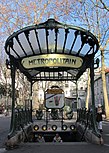




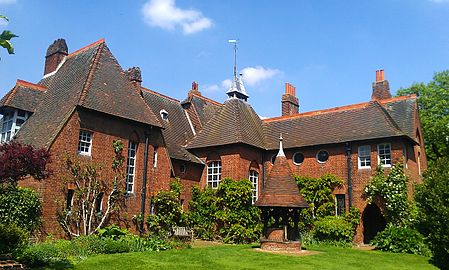




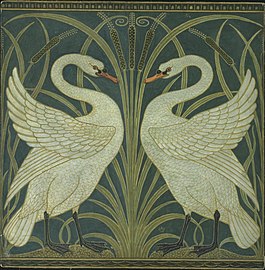


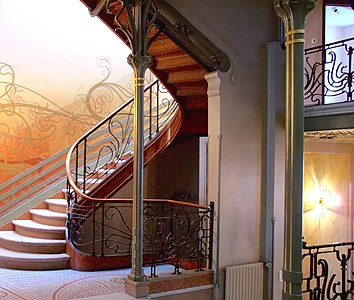



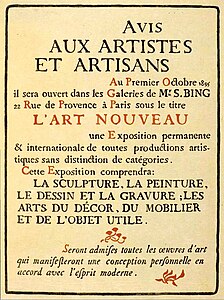




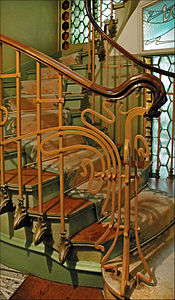


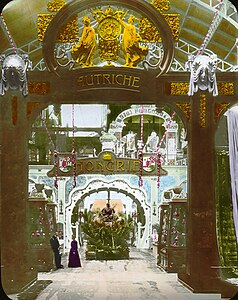
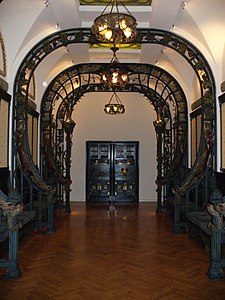


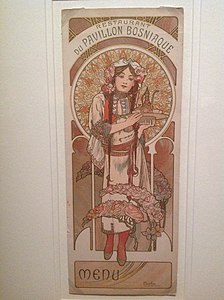


![Doorway of the Lavirotte Building, with ceramic sculptures by Jean-Baptiste Larrivé [fr]](http://upload.wikimedia.org/wikipedia/commons/thumb/4/47/XDSC_7288-29-av-Rapp-paris-7.jpg/176px-XDSC_7288-29-av-Rapp-paris-7.jpg)
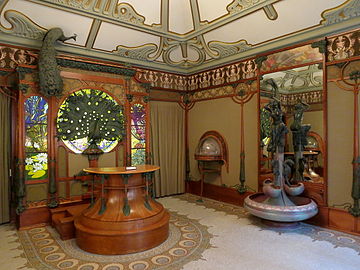



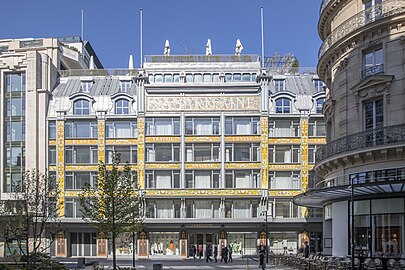
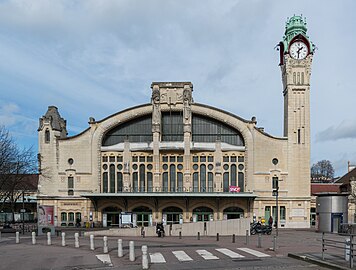


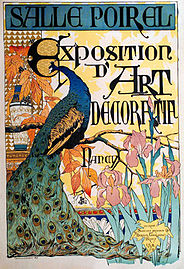





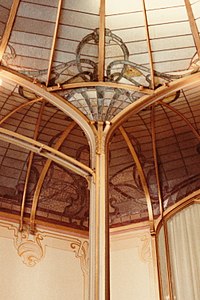
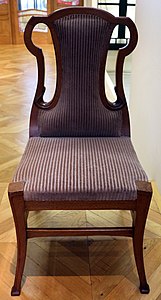



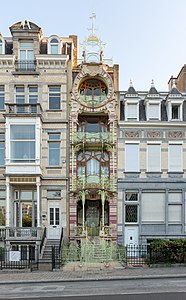
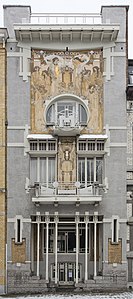
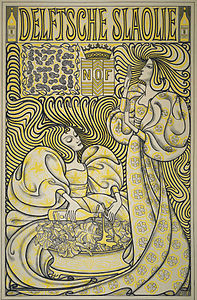





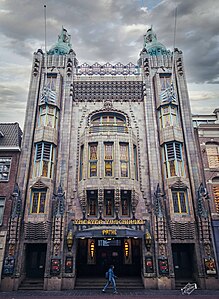




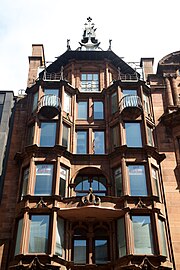

![The May Queen by Margaret Macdonald Mackintosh (1900)[67]](http://upload.wikimedia.org/wikipedia/commons/thumb/a/a8/The_May_Queen%2C_by_Margaret_Macdonald_Mackintosh%2C_1900%2C_pencil%2C_watercolour%2C_and_bodycolour%2C_heightened_with_silver%2C_on_oiled_tracing_paper%2C_33_x_69.2_cm%2C_private_collection.jpg/571px-thumbnail.jpg)
![Interior hallway view, Hill House, Helensburgh, Scotland, designed and built by Walter Blackie (1902–1904)[68]](http://upload.wikimedia.org/wikipedia/commons/thumb/4/4e/Hill_House_7_%2837376578142%29.jpg/317px-Hill_House_7_%2837376578142%29.jpg)
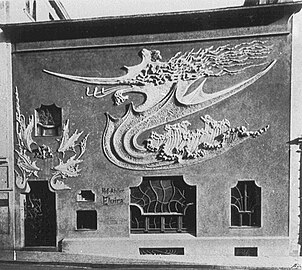





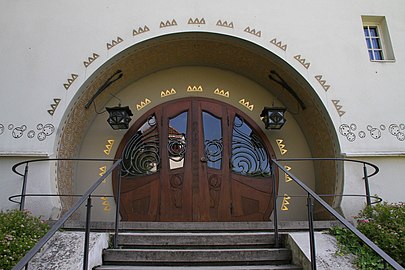









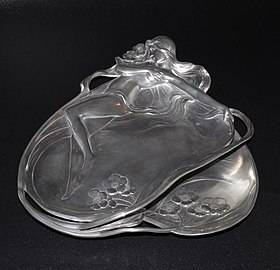


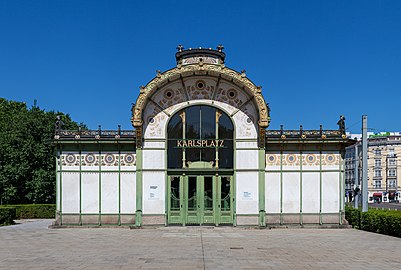






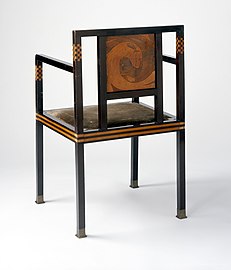
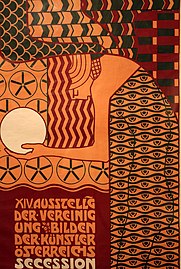
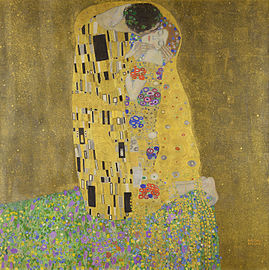
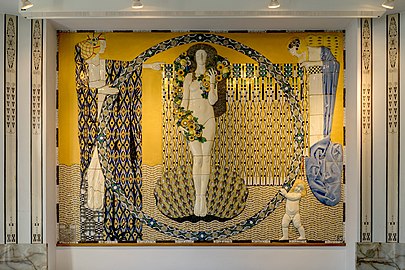
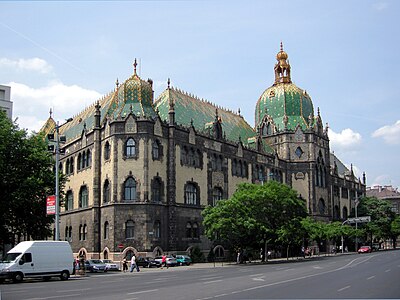


![Mosaic on the façade of Török Bank [fr] building in Budapest by Miksa Róth (1906)](http://upload.wikimedia.org/wikipedia/commons/thumb/2/20/T%C3%B6r%C3%B6k_bankhaz_03.JPG/400px-T%C3%B6r%C3%B6k_bankhaz_03.JPG)


![Brück House in Timișoara, today in Romania (1911). Along with Oradea, Timișoara is part of the Art Nouveau European Route[92]](http://upload.wikimedia.org/wikipedia/commons/thumb/f/f5/Timisoara%2C_Casa_Br%C3%BCck.jpg/240px-Timisoara%2C_Casa_Br%C3%BCck.jpg)

















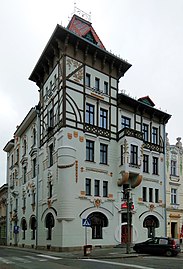

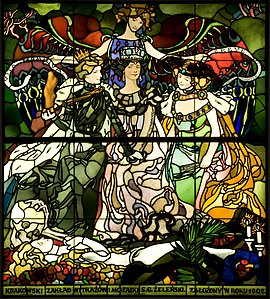


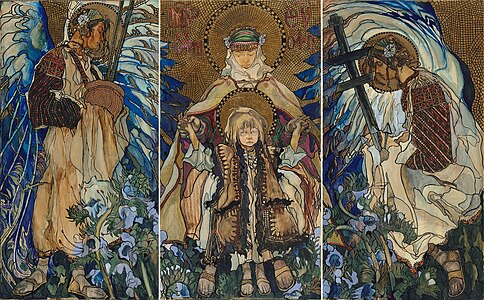











![Romulus Porescu House (Strada Doctor Paleologu no. 12) in Bucharest by Dimitrie Maimarolu (1905)[101]](http://upload.wikimedia.org/wikipedia/commons/thumb/a/a9/Old_photo_of_the_Romulus_Porescu_House_in_Bucharest_%2801%29.jpg/449px-Old_photo_of_the_Romulus_Porescu_House_in_Bucharest_%2801%29.jpg)

![Former Al. Assan shop (Strada Lipscani no. 72–74) in Bucharest, unknown architect (before 1906)[102]](http://upload.wikimedia.org/wikipedia/commons/thumb/1/11/72-74_Strada_Lipscani%2C_Bucharest_%2801%29.jpg/214px-72-74_Strada_Lipscani%2C_Bucharest_%2801%29.jpg)
![Mița the Cyclist House in Bucharest by Nicolae C. Mihăescu (1908), mix of Beaux Arts and Art Nouveau[103]](http://upload.wikimedia.org/wikipedia/commons/thumb/4/41/9_Strada_Biserica_Amzei%2C_Bucharest_%2801%29.jpg/268px-9_Strada_Biserica_Amzei%2C_Bucharest_%2801%29.jpg)




![Stove in the Mița the Cyclist House (Strada Biserica Amzei no. 9), Bucharest, possibly designed by Nicolae C. Mihăescu (1908)[103]](http://upload.wikimedia.org/wikipedia/commons/thumb/2/2c/Art_Nouveau_polychrome_tiled_stove_in_the_Mi%C8%9Ba_the_Cyclist_House%2C_Bucharest_%2804%29.jpg/388px-Art_Nouveau_polychrome_tiled_stove_in_the_Mi%C8%9Ba_the_Cyclist_House%2C_Bucharest_%2804%29.jpg)
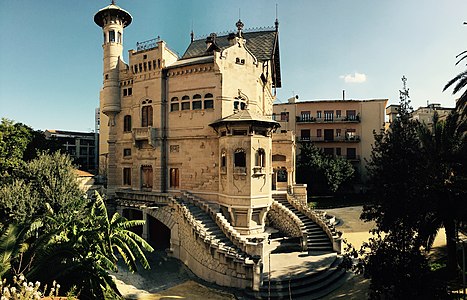




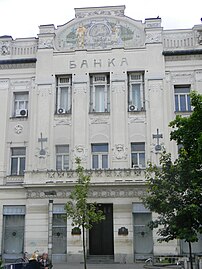



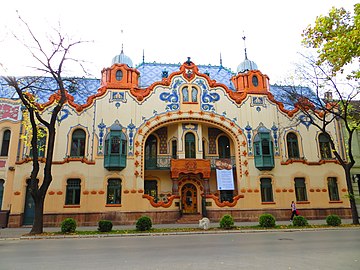










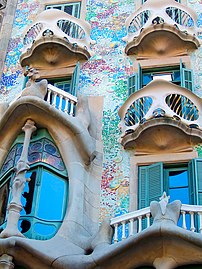
![Casa Milà in Barcelona by Gaudí (1906–1912)[116]](http://upload.wikimedia.org/wikipedia/commons/thumb/d/de/Casa_Mil%C3%A0%2C_general_view.jpg/347px-Casa_Mil%C3%A0%2C_general_view.jpg)
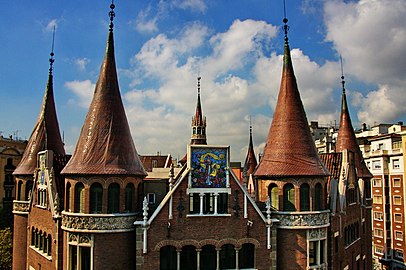
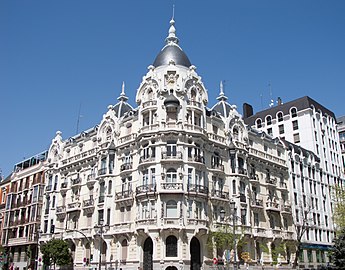
![Sanctuary of Maria Magdalena [ca] in Novelda, Valencian Community (1918–1946)](http://upload.wikimedia.org/wikipedia/commons/thumb/2/28/Santuario_Novelda.jpg/202px-Santuario_Novelda.jpg)

![Sculpture of polychrome terracota by Lambert Escaler [ca] (1902)](http://upload.wikimedia.org/wikipedia/commons/thumb/c/c1/El_Pet%C3%B3_Perdut._Lambert_Escaler_i_Mil%C3%A0.JPG/180px-El_Pet%C3%B3_Perdut._Lambert_Escaler_i_Mil%C3%A0.JPG)
![Furniture by Gaspar Homar [ca] (1903)](http://upload.wikimedia.org/wikipedia/commons/thumb/b/b6/140_La_sardana%2C_plaf%C3%B3_de_marqueteria_de_Gaspar_Homar.jpg/360px-140_La_sardana%2C_plaf%C3%B3_de_marqueteria_de_Gaspar_Homar.jpg)





![Façade of Major Pessoa Residence in Aveiro (1907–1909)[124]](http://upload.wikimedia.org/wikipedia/commons/thumb/4/4e/Aveiro_Casa_do_Major_Pessoa_856.jpg/200px-Aveiro_Casa_do_Major_Pessoa_856.jpg)

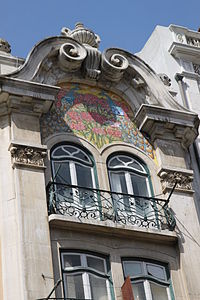






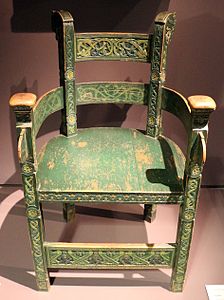
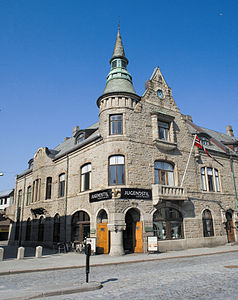
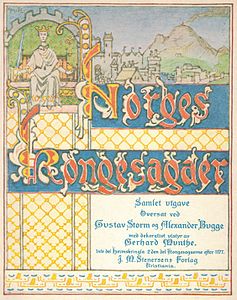
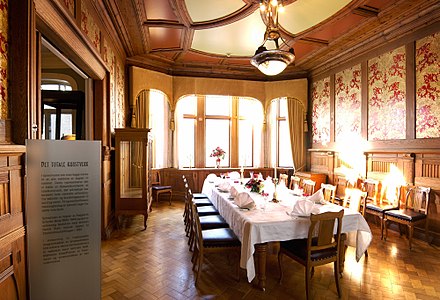







![An Art Nouveau Fabergé egg[nb 3] (1898)](http://upload.wikimedia.org/wikipedia/commons/thumb/2/22/Faberg%C3%A9_egg_Rome_03.JPG/141px-Faberg%C3%A9_egg_Rome_03.JPG)






